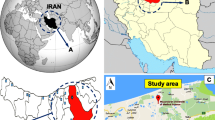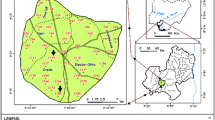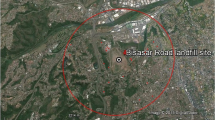Abstract
The present study is focused on the relationship of school community personal exposure of respirable particulate matter (RPM) with its indoor and ambient outdoor component. A representative longitudinal study design has been adopted. School community is divided into two categories: (1) subjects of science discipline and (2) subjects of nonscience discipline. On the basis of local meteorological parameters and school building constructions, three schools have been identified for the study. Selected subjects have been monitored for 24-h personal RPM exposure along with school indoor and respective outdoor RPM. Paired samples of ambient PM10 and RPM were collected to establish the correlation between them. Regressions between school indoor and ambient outdoor RPM have shown strong positive relationships in case of two schools having moderate ventilation. The highest RPM to PM10 ratio (0.62) has occurred at school X located near the steel plant downwind. Almost all indoor and ambient outdoor RPM levels exceed Indian National Ambient Air Quality Standards (NAAQS; 60 μg m − 3). Highest levels of indoor and ambient outdoor RPM have occurred in school X located near the steel plant. Subjects belonging to the school located near the steel plant (school X) have shown five to six times higher values of RPM compared to NAAQS standards.
Similar content being viewed by others
References
Brook, J. R., Dann, T. F., & Burnett, R. T. (1997). The relationship among TSP, PM10, PM2.5 and inorganic constituents of atmospheric particulates matter at multiple Canadian location. Journal of the Air & Waste Management Association, 47, 2–19.
Davis, D. L., Saldiva, P. H. N., Ahmad, A. K., Carreira, J., Miraglia, S., Bandhari, R., et al. (1999). Urban air pollution risks to children: A global environmental health indicator. World Resources Institute: Washington D.C.
Duan, N. (1980). Microenvironment types: A model for human exposure to air pollution (SIMS Technical Report). Standard, USA, Department of Statistics, Stanford University.
Environmental Protection Agency (1991). Introduction to indoor air quality: A reference manual. United State Environmental Protection Agency, United State Public Health Service. National Environmental Health Association.
Environmental Protection Agency (2002). Third external review draft of air quality criteria for particulate matter (Vol. I and II).
Environmental Protection Agency (2003). Fourth external review draft of air quality criteria for particulate matter (Vol. I and II).
Envirotech (2000). Background material for short course on ambient air quality and management. New Delhi: Envirotech Center for Research and Development.
Evans, G., Highsmith, R. V., Sheldon, L. S., Suggs, J. C., Willams, R. W., Zweidinger, R. B., et al. (2000). The 1999 Fresno particulate matter exposure studies: Comparison of community, outdoor and residential PM mass measurements. Journal of the Air & Waste Management Association, 50, 1887–1896.
Gajghate, D. G., & Hassan, M. Z. (1999). Ambient lead levels in urban areas. Bulletin of Environmental Contamination and Toxicology, 62, 403–404. doi:10.1007/s001289900889.
Gilbert, R. O. (1987). Statistical methods for environmental pollution monitoring. New York: Wiley.
Goel, P. K., & Trivedi, R. K. (1998). An introduction to air pollution. Jaipur: Techno Science.
Gold, D. R., Litonjua, A., Schwartz, J., Lovett, E., & Larson, A. (2000). Ambient pollution and heart rate variability. Circulation, 101, 1267–1273.
Kulkarni, M. M., & Patil, R. S. (1999). Monitoring of daily integrated exposure of outdoor workers to respirable particulate matter in an urban region of India. Environmental Monitoring and Assessment, 56(2), 129–146. doi:10.1023/A:1005947301971.
Liao, D. P., Creason, J., Shy, C., Williams, R., Watts, R., & Zweinger, R. (1999). Daily variation of particulate air pollution and poor cardiac autonomic control in the elderly. Environmental Health Perspectives, 107, 521–525. doi:10.2307/3434393.
MEF (1994). National ambient air quality standard. Ministry of Environment and Government of India notification.
Morand, P. C., Schillinger, C., Armengaurd, A., Debotte, G., Chretien, S. P., & Maesano, I. A. (2006). ISAAC-France, assessment of school children’s exposure to traffic-related air pollution in the French six cities using a dispersion model. Atmospheric Environment, 40, 2274–2287. doi:10.1016/j.atmosenv.2005.11.057.
Mukharjee, S., & Ray, M. K. (1991). Significance of humidity on ambient SPM dispersion: Macro and micro level case study. Indian Journal of Environmental Protection, 11(9), 683–688.
National Research Council (1993). Pesticides in the diets of infants and children. Washington, DC: National Academy Press.
Noullet, M., Jackson, P. L., & Brauer, M. (2006). Winter measurements of children’s personal exposure and ambient fine particle mass, sulphate and light absorbing components in a northern community. Atmospheric Environment, 40, 1971–1990. doi:10.1016/j.atmosenv.2005.11.038.
Pope, C. A., Verrier, R. L., Lovertt, E. G., Larson, A. C., Raizenne, M. E., Kanner, R. E., et al. (1999). Heart rate variability associated with particulate air pollution. American Heart Journal, 138, 890–899. doi:10.1016/S0002-8703(99)70014-1.
Roosli, M. (2001). Spatial variability of air pollutants in the Basel area and carcinogenic and non-carcinogenic health risk. Ph.D. Thesis, University of Basel, Switzerland.
Sax, I. N., & Lewis, R. J. (1989). Dangerous properties of industries of industrial material (VIIth ed., Vol. 3). New York: Von Nostrand.
Schwartz, J. (2006). Air pollution and children’s health. Pediatrics, 113(4), 1037–1043.
Smith, K. R., Agrawal, A. L., & Dave, R. M. (1984). Status of India’s environment (Vol. 85, p. 124).
Weisel, C. P., Zhang, J., Turnip, B. J., Morandi, M. T., Colome, S., Stock, T. H., et al. (2004). Relationship of indoor, outdoor and personal air (RIOPA) study: Study design, methods and quality assurance/control results. Journal of Exposure Analysis and Environmental Epidemiology, 15, 123–137.
Williams, R., Suggs, J., Zweidinger, R., Evans, G., Creason, J., Kwok, R., et al. (2000a). The 1998 Baltimore particulate matter epidemiology-exposure study: Part-1. Comparison of ambient, residential outdoors, indoor and apartment particulate matter monitoring. Journal of Exposure Annual Environmental Epidemiology, 10, 518–532. doi:10.1038/sj.jea.7500107.
Williams, R., Suggs, J., Creason, J., Roads, C., Lawless, P., Kwok, R., et al. (2000b). The 1998 Baltimore particulate matter epidemiology-exposure study: Part-2. Personal exposure assessment associated with an elderly study population. Journal of Exposure Annual Environmental Epidemiology, 10, 533–543. doi:10.1038/sj.jea.7500108.
Williams, R., Creason, J., Zweidinger, R., Watts, R., Sheldon, L., & Shy, C. (2000c). Indoor, outdoor and personal exposure monitoring of particulate air pollution: The Baltimore elderly epidemiology exposure pilot study. Atmospheric Environment, 34, 4193–4204. doi:10.1016/S1352-2310(00)00209-0.
Wilson, W. E., Mage, D. T., & Grant, L. D. (2000). Estimating separately personal exposure to ambient particulate matter for epidemiology and risk assessment: Why and how. Journal of the Air & Waste Management Association, 50, 1167–1183.
Author information
Authors and Affiliations
Corresponding author
Rights and permissions
About this article
Cite this article
Gadkari, N.M. Study of personal–indoor–ambient fine particulate matters among school communities in mixed urban–industrial environment in India. Environ Monit Assess 165, 365–375 (2010). https://doi.org/10.1007/s10661-009-0952-3
Received:
Accepted:
Published:
Issue Date:
DOI: https://doi.org/10.1007/s10661-009-0952-3




